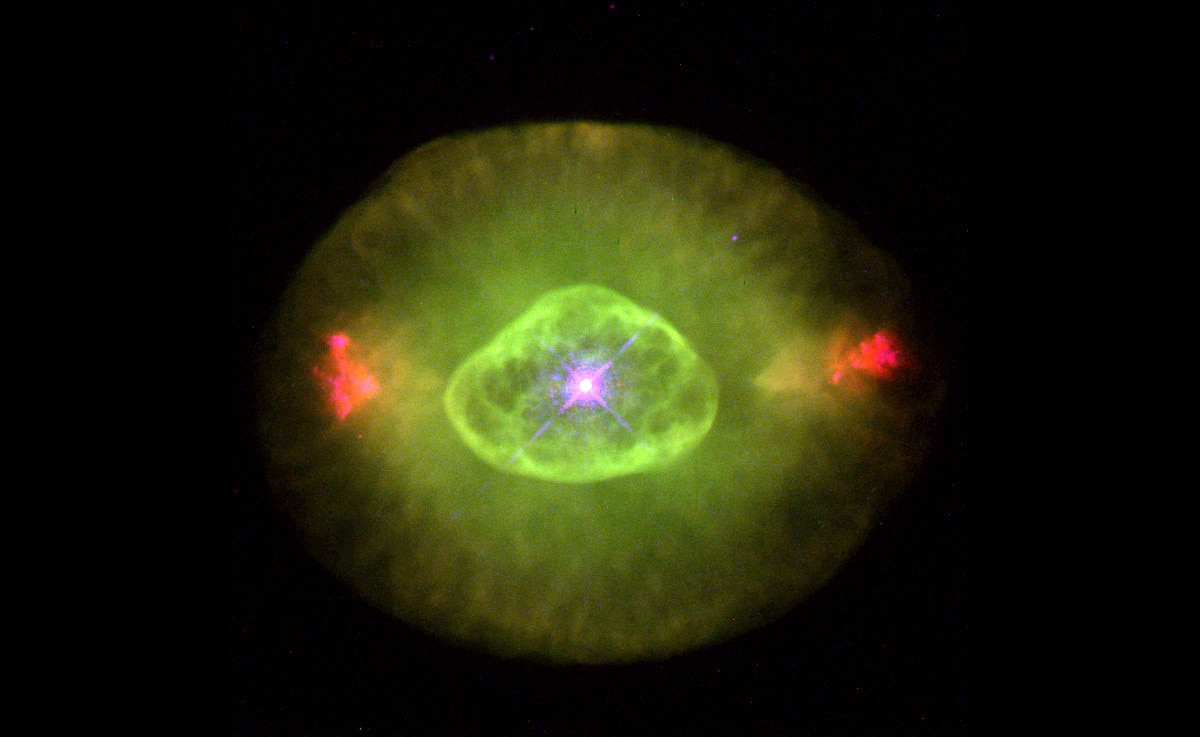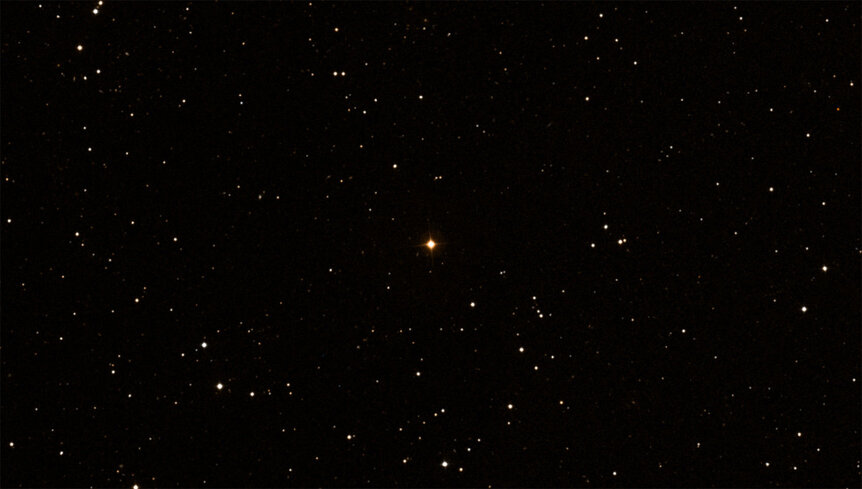Create a free profile to get unlimited access to exclusive videos, sweepstakes, and more!
Astronomers are watching a star die in real time

This too shall pass. Even stars.
Stars seem eternal, but they’re not. They may live for billions of years, but they eventually die. How exactly they do this depends on lots of things, most importantly their mass: High-mass stars explode, while stars that are more Sun-like in their mass do so more slowly.
The Sun is many billions of years away from swelling into a red giant, shedding its outer layers, revealing its core as a tiny, hot white dwarf, and then fading away over time. But the star T Ursae Minoris (or T UMi) is already a red giant, and has been showing signs it’s entering its terminal count.
What’s really cool about this is that it’s changing rapidly right now, quickly enough that astronomers have been able to watch these changes occurring over just a few years (though it’s more obvious over many decades). T UMi is dying, and we’re watching it happen.
The engine behind all this lies deep inside the star. During a star’s “normal life”, hydrogen fuses into helium in the core. The helium takes far higher pressures and temperatures to fuse, so it builds up in the center, inert. If the star has enough mass, eventually enough helium builds up to start fusing into carbon and oxygen. That then builds up, inert, a dense lump of incredibly hot and compressed matter roughly the size of the Earth.
Some stars have enough mass that this C/O ball will eventually start to fuse as well, creating progressively heavier elements, leading (in stars with more than about 8 times the Sun’s mass) to an explosion: supernova. But for stars more like the Sun the process ends here. Kinda…
That ball of carbon and oxygen is fiercely hot. Even if the star itself lacks the pressure to continue to fuse helium, the energy radiating upward from that core is so huge it can ignite helium fusion around it. This happens in a thin spherical shell around the core. Not only that, but the helium fusion generates enough energy to create a shell of hydrogen fusing around it! In these cases the core is not fusing at all; all the action is happening around it.
In the meantime, all this energy being generated in the center of the star gets dumped into the outer layers (which are mostly hydrogen). When you heat a gas it expands, and so the star swells up, becoming a giant. The energy it emits per square centimeter on its surface, though, actually drops, so it cools and becomes red. We call such stars red giants.
However, this situation is not stable. [Note: All of the stuff I’m describing here is outlined in much more detail in my book Death from the Skies! which all the cool kids are buying.] The physics of thin shell helium fusion is such that the rate of fusion is ridiculously sensitive to temperature — it literally goes as the 40th power of temperature! If the temperature goes up by, say, 20%, the rate of fusion in the helium shell will increase by well over a factor of a thousand! So any change in the conditions and the fusion rate jumps hugely, generating a lot of energy very rapidly.
And that does happen. The inert core shrinks under the force of its own gravity, and heats up. That heat goes into the helium shell, which responds by fusing faster, and eventually a tipping point is reached. The rate becomes so huge that it essentially uses up all the helium in one sudden flash.
This is called a thermal pulse, and the name is pretty mundane compared to the mind-numbing amounts of energy it dumps into the star. This makes the outer layers expand so rapidly the star’s gravity can’t hold on, and the material is ejected, blasted away from the star and into space.
After that, things settle down, but the cycle repeats. The helium starts to fuse in a thin shell again, things spiral out of control, and boom! A star like the Sun will go through this several times before the outer layers are completely ejected, the intensely hot white dwarf core is exposed, and the energy from it makes the ejected outer layers glow, becoming a planetary nebula.
T UMi is undergoing this right now. The new paper out about it indicates that over the past century or so it’s showing signs that it recently underwent just such a thermal pulse! This has never been seen before.
T UMi is what’s called a Mira-type variable. Besides being a red giant undergoing thermal pulses, the outer layers themselves pulsate, literally expanding and contracting. This is a different phenomenon from the pulse (note the different words being used). At the pressure and temperatures that exist in the outer layers, conditions are such that the gas expands and contracts on a timescale of about a year. This is fairly common in stars like this.
But what’s weird is that over the past century, these pulsations have changed significantly. Just a century or so ago the star went through a cycle of contracting and expanding again about once every 310 days. That cycle now takes just about 200 days! That’s a huge change. These pulsations affect the star’s brightness; when it contracts it gets hotter but the surface area shrinks, which in the end makes the star fainter. When it expands it has a lot more surface area emitting light so it gets brighter. These changes are pretty easy to measure even with a small telescope, and in fact the research relies on amateur observations of T UMi over the past several decades.
The authors of the study posit that the star underwent a pulse just a few decades ago, and this is what’s affecting the outer layer pulsations. They predict the star’s pulsation rate will continue to shrink for about another 50 years before slowing again — that’s a testable prediction, and one that an astronomer can observe over single lifetime. That’s astonishing! Most changes in stars take millennia or even more.
The models they made to work all this out also give some numbers for the star. It probably started with twice the mass of the Sun and has lost about 15% of that due to ejections from thermal pulses. It’s about 1.2 billion years old — more massive stars age faster. Also, it’s definitely a red giant, since it’s diameter is nearly 300 times the Sun’s — about 400 million kilometers. If the Sun were that big it would engulf the Earth and nearly be big enough to swallow Mars!
This too will eventually be the fate of the Sun. I wouldn’t worry about it on a personal level too much; it won’t even start to undergo thermal pulses for another 7.7 billion years. Or so. Plenty of time to get your affairs in order, I’d wager.
But this is of great scientific interest. The Sun is the nearest star to us and the one that is arguably best studied. Understanding its behavior leads us to understand stellar behavior in general. And, of course, there’s a certain morbid fascination with how the Sun will shuffle off its own mortal coil. It probably won’t get big enough to engulf the Earth (as it loses mass its gravitational hold on Earth weakens, so our orbit expands, probably enough to keep it from getting swallowed up), and new works shows the exposed core of the Sun may be hot enough to make the ejected gas become a planetary nebula.
That’ll be pretty! For aliens living eons from now, I suppose.
In the meantime observations of T UMi will continue, and we can keep watching this saga unfold before us. It amazes me that we can use our knowledge of physics to understand what happens hundreds of millions of kilometers beneath the surfaces of stars, and observe them to see if it all works… and it’s even more amazing that it does work.
We understand in some ways how stars die. Science is wonderful.
















